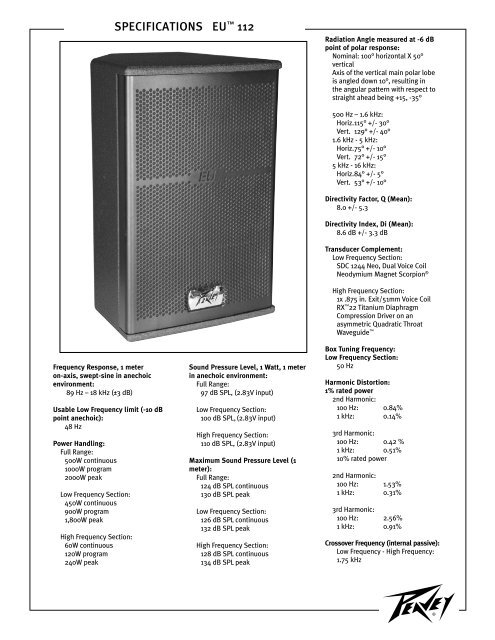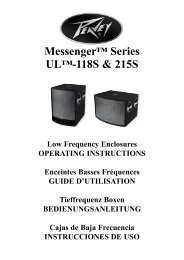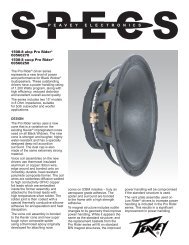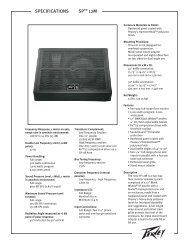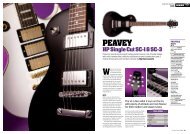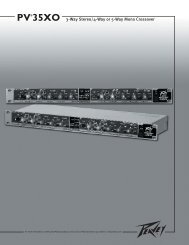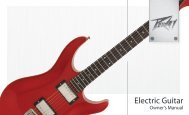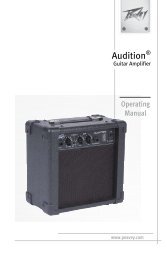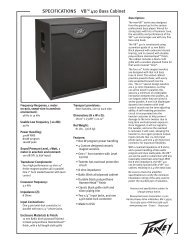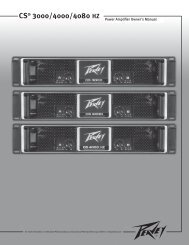EU 112 - Peavey
EU 112 - Peavey
EU 112 - Peavey
You also want an ePaper? Increase the reach of your titles
YUMPU automatically turns print PDFs into web optimized ePapers that Google loves.
SPECIFICATIONS <strong>EU</strong> <strong>112</strong><br />
Radiation Angle measured at -6 dB<br />
point of polar response:<br />
Nominal: 100° horizontal X 50°<br />
vertical<br />
Axis of the vertical main polar lobe<br />
is angled down 10°, resulting in<br />
the angular pattern with respect to<br />
straight ahead being +15, -35°<br />
Frequency Response, 1 meter<br />
on-axis, swept-sine in anechoic<br />
environment:<br />
89 Hz – 18 kHz (±3 dB)<br />
Usable Low Frequency limit (-10 dB<br />
point anechoic):<br />
48 Hz<br />
Power Handling:<br />
Full Range:<br />
500W continuous<br />
1000W program<br />
2000W peak<br />
Low Frequency Section:<br />
450W continuous<br />
900W program<br />
1,800W peak<br />
High Frequency Section:<br />
60W continuous<br />
120W program<br />
240W peak<br />
Sound Pressure Level, 1 Watt, 1 meter<br />
in anechoic environment:<br />
Full Range:<br />
97 dB SPL, (2.83V input)<br />
Low Frequency Section:<br />
100 dB SPL, (2.83V input)<br />
High Frequency Section:<br />
110 dB SPL, (2.83V input)<br />
Maximum Sound Pressure Level (1<br />
meter):<br />
Full Range:<br />
124 dB SPL continuous<br />
130 dB SPL peak<br />
Low Frequency Section:<br />
126 dB SPL continuous<br />
132 dB SPL peak<br />
High Frequency Section:<br />
128 dB SPL continuous<br />
134 dB SPL peak<br />
500 Hz – 1.6 kHz:<br />
Horiz. 115° +/- 30°<br />
Vert. 129° +/- 40°<br />
1.6 kHz - 5 kHz:<br />
Horiz. 75° +/- 10°<br />
Vert. 72° +/- 15°<br />
5 kHz - 16 kHz:<br />
Horiz. 84° +/- 5°<br />
Vert. 53° +/- 10°<br />
Directivity Factor, Q (Mean):<br />
8.0 +/- 5.3<br />
Directivity Index, Di (Mean):<br />
8.6 dB +/- 3.3 dB<br />
Transducer Complement:<br />
Low Frequency Section:<br />
SDC 1244 Neo, Dual Voice Coil<br />
Neodymium Magnet Scorpion ®<br />
High Frequency Section:<br />
1x .875 in. Exit/51mm Voice Coil<br />
RX 22 Titanium Diaphragm<br />
Compression Driver on an<br />
asymmetric Quadratic Throat<br />
Waveguide <br />
Box Tuning Frequency:<br />
Low Frequency Section:<br />
50 Hz<br />
Harmonic Distortion:<br />
1% rated power<br />
2nd Harmonic:<br />
100 Hz: 0.84%<br />
1 kHz: 0.14%<br />
3rd Harmonic:<br />
100 Hz: 0.42 %<br />
1 kHz: 0.51%<br />
10% rated power<br />
2nd Harmonic:<br />
100 Hz: 1.53%<br />
1 kHz: 0.31%<br />
3rd Harmonic:<br />
100 Hz: 2.56%<br />
1 kHz: 0.91%<br />
Crossover Frequency (internal passive):<br />
Low Frequency - High Frequency:<br />
1.75 kHz
SPECIFICATIONS <strong>EU</strong> <strong>112</strong><br />
Recommended Active Crossover<br />
Frequency Region and Slope:<br />
Low Frequency - High Frequency:<br />
1800 Hz at 24 dB/octave<br />
Note: This is a general purpose setting<br />
for analog crossovers, for crossover/<br />
processor settings compatible with<br />
<strong>Peavey</strong> digital crossover processors,<br />
and many other brands of digital<br />
processors, see page 8 for detailed<br />
settings.<br />
Time Offset:<br />
Low Frequency:<br />
High Frequency:<br />
0.37 ms, delay<br />
0.0 ms<br />
Impedance (Z) in ohms (Ω):<br />
Full Range:<br />
Nominal: 8.0 Ω<br />
Minimum: 5.7 Ω<br />
Low Frequency:<br />
Nominal:<br />
Minimum:<br />
High Frequency:<br />
Nominal:<br />
Minimum:<br />
8.0 Ω<br />
5.7 Ω<br />
8.0 Ω<br />
5.4 Ω<br />
Input Connections:<br />
Two 4-pin twist lock connectors in<br />
parallel for full range input, and one<br />
4-pin switching Neutrik ® Speakon ®<br />
jack for bi-amp use.<br />
Enclosure Materials & Finish:<br />
Thirteen ply 18 mm birch plywood<br />
finished in black HammerHead <br />
polyurethane finish<br />
Full-length wrap-around 16 ga.<br />
perforated steel grille with an inner<br />
polycloth liner and a black powder<br />
coat finish.<br />
Mounting provisions:<br />
This unit is not designed for<br />
overhead suspension.<br />
Dual-angle stand mount adapter<br />
built-in, and four large rubber feet<br />
on bottom for floor use.<br />
Dimensions (H x W x D):<br />
Front:<br />
23.88 in. x 15.13 in. x 16.25 in.<br />
606 mm x 384 mm x 413 mm<br />
Rear:<br />
23.88 in. x 7.88 in. x 16.25 in.<br />
606 mm x 200 mm x 413 mm<br />
Net Weight:<br />
45 Lbs. (20.5 kg)<br />
Features<br />
• 2-way full range sound<br />
reinforcement system<br />
• RX 22 compression driver with<br />
ferrofluid cooling<br />
• 12” Scorpion ® Neo dual voice coil<br />
woofer<br />
• 1000 W program, 2000 W peak<br />
• Patented Quadratic Throat<br />
Waveguide technology<br />
• Asymmetrical horn aims the<br />
sound down 10°, at the audience,<br />
not over their heads.<br />
• Monitor use with angled side/rear<br />
panel (monitor use rubber feet<br />
provided)<br />
• Sound Guard III tweeter<br />
protection<br />
• Full range inputs are two 4-pin<br />
twist lock connectors, and one<br />
switching Neutrik ® Speakon ®<br />
bi-amp jack<br />
• Trapezoidal birch plywood<br />
enclosure<br />
• Durable HammerHead <br />
polyurethane finish<br />
• Dual angle stand mount adapter<br />
Description<br />
The <strong>EU</strong> <strong>112</strong> has a new asymmetrical<br />
Quadratic Throat Waveguide for<br />
the tweeter, and an enclosure made<br />
from birch plywood. It is a two-way<br />
speaker system comprised of a<br />
high output 12” Scorpion ® Neo dual<br />
voice coil woofer and an RX 22<br />
compression driver loaded onto<br />
the patented Quadratic Throat<br />
Waveguide .<br />
The <strong>EU</strong> <strong>112</strong> has a trapezoidal<br />
shaped multi-angled enclosure,<br />
which reduces the build-up of<br />
standing waves inside the enclosure,<br />
which minimizes mid-bass and<br />
mid-range coloration’s due to the<br />
cabinet. It is constructed of 13-ply<br />
birch plywood and is finished in<br />
a durable black HammerHead <br />
finish. A full-length wrap-around<br />
powder-coated perforated metal<br />
grille covers the front of the cabinet,<br />
providing a very smooth look. One<br />
side is multi-angled to allow use as a<br />
floor monitor, and a dual angle stand<br />
mount adapter is built-in on one end<br />
for precision and ease of speaker<br />
stand use.<br />
The low frequencies are supplied<br />
by a 12” BWX DVC 12 Neo, dual<br />
voice coil woofer and a highly linear<br />
suspension. The dual voice coils<br />
in conjunction with a Neodymium<br />
magnet structure with extensive<br />
heat sink fins provide an outstanding<br />
power handling capability of over<br />
450W for the woofer. The high<br />
frequencies are handled by an<br />
RX 22 2” titanium diaphragm<br />
compression driver utilizing ferrofluid<br />
cooling. This superb driver is coupled<br />
to a Quadratic Throat constant<br />
directivity waveguide, covered under<br />
US patent #6,059,069 with smooth,<br />
even response, low distortion and<br />
good high frequency dispersion.<br />
This horn has an asymmetrical<br />
vertical polar response, aiming the<br />
main energy lobe down 10°, so it is<br />
aimed at the audience, instead of<br />
over their heads. This helps reduce<br />
ceiling reflections for greater clarity<br />
and gain before feedback. The RX <br />
22 driver features the Radialinear<br />
Planar Phase Correction System,<br />
under US Patent 6,064,745, which<br />
provides smoother and extended<br />
high frequency response.<br />
Input connection to the system<br />
is made via two 4-pin twist lock<br />
connectors in parallel, and a<br />
switching Neutrik ® Speakon ® bi-amp<br />
jack is also provided. The internal<br />
passive crossover features the Sound<br />
Guard III tweeter protection circuit,<br />
and an advanced topology crossover<br />
with high performance components,<br />
to provide high power handling<br />
and reliability. <strong>Peavey</strong>’s proprietary<br />
high-frequency driver protection<br />
circuitry, Sound Guard , provides<br />
long and medium term driver<br />
overload protection when the system<br />
is used full-range, without impairing<br />
musical transients or dynamics. The<br />
crossover provides driver roll-off and<br />
protection, as well as driver EQ for<br />
the woofer and horn, the sum total is<br />
a clean, clear and smooth response.<br />
High-quality, reliable crossover<br />
components include polypropylene<br />
capacitors, and high current<br />
inductors. The optimal integration<br />
of the crossover with the selected<br />
drivers results in a smooth frequency<br />
response from 89 Hz to 18 kHz.<br />
Despite its compact dimensions and<br />
light weight for a 12” based two-way<br />
enclosure, this system can put out<br />
some very serious sound levels, and<br />
take 1000 watts program of clean<br />
amplifier power, resulting in clean<br />
coverage with high articulation and<br />
good reliability.<br />
2
SPECIFICATIONS <strong>EU</strong> <strong>112</strong><br />
Frequency Response<br />
This measurement is useful in determining how accurately a<br />
given unit reproduces an input signal. The frequency response<br />
of the <strong>EU</strong> <strong>112</strong> is measured at a distance of 1-meter using a 1<br />
watt (into the nominal impedance) swept-sine input signal. As<br />
shown in figure 1, the selected drivers in the combine to give a<br />
smooth frequency response from 89 Hz to 18 kHz.<br />
Directivity<br />
Beamwidth is derived from the -6 dB points from the polar<br />
plots (see figure 3), which are measured in a whole space<br />
anechoic environment. Q and Directivity Index are plotted for<br />
the on-axis measurement position. These are specifications<br />
that provide a reference to the coverage characteristics of the<br />
unit. These parameters provide insight for proper placement<br />
and installation in the chosen environment. The blending of<br />
the components of the exhibit a desirable beamwidth and<br />
directivity (figure 3 & 4) suitable for sound reinforcement<br />
applications.<br />
Power Handling<br />
There are many different approaches to power handling<br />
ratings. <strong>Peavey</strong> rates this loudspeaker system’s power<br />
handling using a full-range form of the AES Standard 2-1984.<br />
Using audio band 20 Hz to 20 kHz pink noise with peaks of<br />
four times the RMS level, this strenuous test signal assures<br />
the user that every portion of this system can withstand<br />
today’s high technology music. This rating is contingent upon<br />
having a minimum of 3 dB of amplifier headroom available.<br />
Harmonic Distortion<br />
Second and third harmonic distortions vs. frequency are<br />
plotted in figures 5 & 6 for two power levels. Ten percent<br />
(10%) of rated input power and either one percent (1%)<br />
of rated input power or one watt, whichever is greater.<br />
Distortion is read from the graph as the difference between<br />
the fundamental signal (frequency response) and the desired<br />
harmonic. As an example, a distortion curve that is down 40<br />
dB from the fundamental is equivalent to 1% distortion.<br />
Mounting<br />
This unit is not designed for over head suspension. A metal<br />
stand mount adapter is incorporated, and five large rubber<br />
feet on the bottom for floor use. Four low-profile rubber feet<br />
are supplied along with four black screws to allow the end<br />
user to install feet on the monitor side wall for frequent use in<br />
the monitor position.<br />
Architectural & Engineering Specifications<br />
The loudspeaker system shall have an operating bandwidth<br />
of 89 Hz to 18 kHz. The nominal output level shall be 96 dB<br />
when measured at a distance of one meter with an input<br />
of one watt. The nominal impedance shall be 8 ohms. The<br />
maximum continuous power handling shall be 500 watts,<br />
maximum program power of 1000 watts and a peak power<br />
input of at least 2000 watts, with a minimum amplifier<br />
headroom of 3 dB. The nominal radiation geometry shall be<br />
100° in the horizontal plane and 50° in the vertical plane.<br />
The outside dimensions shall be 23.88” high x 15.13” wide x<br />
16.25” deep. The weight shall be 45 pounds. The loudspeaker<br />
system shall be a <strong>Peavey</strong> model <strong>EU</strong> <strong>112</strong>.<br />
Notes On Use As a Monitor<br />
When using the <strong>EU</strong> <strong>112</strong> as a floor monitor, the best axis<br />
to listen on when in close for monitor use, is in line with<br />
the woofer. This is due to the designed-in polar tilt of the<br />
asymmetrical Quadratic Throat Waveguide . Four low-profile<br />
rubber feet are supplied along with four black screws to allow<br />
the end user to install feet on the monitor side wall so that<br />
the cabinet will not vibrate against or slide across the floor.<br />
dB SPL (re 20 Pa)<br />
110<br />
100<br />
90<br />
80<br />
70<br />
Amplitude Response (1W 1m On-Axis)<br />
60<br />
20 50 100 200 500 1k 2k 5k 10k 20k<br />
Figure 1<br />
Frequency (Hz)<br />
100<br />
50<br />
30<br />
20<br />
Z<br />
( ) 10<br />
Beamwidth (Degrees)<br />
dB SPL (re 20 Pa)<br />
dB SPL (re 20 Pa)<br />
5<br />
3<br />
2<br />
Impedance<br />
1<br />
20 50 100 200 500 1k 2k 5k 10k 20k<br />
Figure 2<br />
Frequency (Hz)<br />
360<br />
300<br />
180<br />
140<br />
100<br />
80<br />
60<br />
40<br />
30<br />
Horizontal<br />
Vertical<br />
Beamwidth<br />
20 50 100 200 500 1k 2k 5k 10k 20k<br />
Frequency (Hz)<br />
Figure 3<br />
Q<br />
100<br />
10<br />
Q&Directivity Index<br />
1<br />
0<br />
20 50 100 200 500 1k 2k 5k 10k 20k<br />
Figure 4<br />
Frequency (Hz)<br />
110<br />
100<br />
90<br />
80<br />
70<br />
60<br />
50<br />
Harmonic Distortion : 1% Rated Power<br />
40<br />
20 50 100 200 500 1k 2k 5k 10k 20k<br />
Frequency (Hz)<br />
2nd Harmonic<br />
Figure 5<br />
3rd Harmonic<br />
120<br />
110<br />
100<br />
90<br />
80<br />
70<br />
Harmonic Distortion : 10%Full Rated Power<br />
20<br />
10<br />
Di<br />
60<br />
50<br />
20 50 100 200 500 1k 2k 5k 10k 20k<br />
Frequency (Hz)<br />
2nd Harmonic<br />
Figure 6<br />
3rd Harmonic<br />
3
SPECIFICATIONS <strong>EU</strong> <strong>112</strong><br />
Horizontal Polars<br />
30 o<br />
0 o<br />
-30 o<br />
30 o<br />
0 o<br />
-30 o<br />
30 o<br />
0 o<br />
-30 o<br />
60 o<br />
-60 o<br />
60 o<br />
-60 o<br />
60 o<br />
-60 o<br />
90 o 90 o -90 o<br />
-90 o<br />
-90 o<br />
90 o<br />
90 o -90 o<br />
90 o -90 o<br />
-90 o<br />
90 o -90 o<br />
90 o -90 o<br />
90 o -90 o<br />
200 Hz<br />
250 Hz<br />
315 Hz<br />
0 o<br />
0 o<br />
0 o<br />
30 o<br />
-30 o<br />
30 o<br />
-30 o<br />
30 o<br />
-30 o<br />
60 o<br />
-60 o<br />
60 o<br />
-60 o<br />
60 o<br />
-60 o<br />
400 Hz<br />
630 Hz<br />
800 Hz<br />
0 o<br />
0 o<br />
0 o<br />
30 o<br />
-30 o<br />
30 o<br />
-30 o<br />
30 o<br />
-30 o<br />
60 o<br />
-60 o<br />
60 o<br />
-60 o<br />
60 o<br />
-60 o<br />
1000 Hz<br />
1250 Hz<br />
90 o 1600 Hz<br />
30 o<br />
0 o<br />
-30 o<br />
30 o<br />
0 o<br />
-30 o<br />
30 o<br />
0 o<br />
-30 o<br />
60 o<br />
-60 o<br />
60 o<br />
-60 o<br />
60 o<br />
-60 o<br />
90 o -90 o<br />
90 o -90 o<br />
90 o<br />
-90 o<br />
2000 Hz 2500 Hz 3150 Hz<br />
4
SPECIFICATIONS <strong>EU</strong> <strong>112</strong><br />
Horizontal Polars, Continued<br />
30 o<br />
0 o<br />
-30 o<br />
30 o<br />
0 o<br />
-30 o<br />
30 o<br />
0 o<br />
-30 o<br />
60 o<br />
-60 o<br />
60 o<br />
-60 o<br />
60 o<br />
-60 o<br />
90 o 90 o -90 o<br />
90 o -90 o<br />
-90 o<br />
90 o -90 o<br />
90 o -90 o<br />
90 o -90 o<br />
90 o<br />
-90 o<br />
4000 Hz<br />
5000 Hz<br />
6300 Hz<br />
0 o<br />
0 o<br />
0 o<br />
30 o<br />
-30 o<br />
30 o<br />
-30 o<br />
30 o<br />
-30 o<br />
60 o<br />
-60 o<br />
60 o<br />
-60 o<br />
60 o<br />
-60 o<br />
8300 Hz<br />
10000 Hz<br />
12500 Hz<br />
0 o<br />
30 o<br />
-30 o<br />
60 o<br />
-60 o<br />
16000 Hz<br />
5
SPECIFICATIONS <strong>EU</strong> <strong>112</strong><br />
Vertical Polars<br />
90 o -30 o<br />
90 o -30 o<br />
60 o<br />
60 o<br />
60 o<br />
30 o<br />
30 o<br />
30 o<br />
90 o -30 o<br />
0 o<br />
0 o<br />
-90 o -90 o<br />
-90 o -90 o<br />
-90 o -90 o<br />
0 o<br />
-90 o -90 o<br />
-60 o<br />
-60 o<br />
-60 o<br />
-90 o<br />
250 Hz<br />
315 Hz<br />
60 o<br />
60 o<br />
60 o<br />
30 o<br />
30 o<br />
30 o<br />
0 o<br />
0 o<br />
0 o<br />
90 o 90 o 90 o<br />
-30 o<br />
-30 o<br />
-30 o<br />
-60 o<br />
-60 o<br />
-60 o<br />
500 Hz<br />
630 Hz<br />
60 o<br />
60 o<br />
60 o<br />
30 o<br />
30 o<br />
30 o<br />
0 o<br />
0 o<br />
0 o<br />
90 o 90 o 90 o<br />
-30 o<br />
-30 o<br />
-30 o<br />
-60 o<br />
-60 o<br />
-60 o<br />
1000 Hz<br />
1250 Hz<br />
60 o<br />
60 o<br />
60 o<br />
30 o<br />
30 o<br />
30 o<br />
-90 o -90 o -90 o<br />
0 o<br />
0 o<br />
0 o<br />
90 o 90 o 90 o<br />
-30 o<br />
-30 o<br />
-30 o<br />
-60 o<br />
-60 o<br />
-60 o<br />
200 Hz<br />
400 Hz<br />
850 Hz<br />
1600 Hz<br />
2000 Hz<br />
2500 Hz<br />
6
SPECIFICATIONS <strong>EU</strong> <strong>112</strong><br />
Vertical Polars, Continued<br />
90 o -30 o<br />
90 o -30 o<br />
60 o<br />
60 o<br />
60 o<br />
30 o<br />
30 o<br />
30 o<br />
90 o -30 o<br />
0 o<br />
0 o<br />
-90 o -90 o<br />
-90 o -90 o<br />
-90 o<br />
0 o<br />
-90 o -90 o<br />
-60 o<br />
-60 o<br />
-60 o<br />
-90 o<br />
4000 Hz<br />
5000 Hz<br />
60 o<br />
60 o<br />
60 o<br />
30 o<br />
30 o<br />
30 o<br />
0 o<br />
0 o<br />
0 o<br />
90 o 90 o 90 o<br />
-30 o<br />
-30 o<br />
-30 o<br />
-60 o<br />
-60 o<br />
-60 o<br />
8000 Hz<br />
10000 Hz<br />
60 o<br />
60 o<br />
30 o<br />
30 o<br />
0 o<br />
0 o<br />
90 o 90 o<br />
-30 o<br />
-30 o<br />
-60 o<br />
-60 o<br />
3150 Hz<br />
6300 Hz<br />
12500 Hz<br />
16000 H<br />
7
SPECIFICATIONS <strong>EU</strong> <strong>112</strong><br />
<strong>EU</strong> <strong>112</strong> Crossover/Processor Settings & EQ<br />
Infrasonic filtering:<br />
Filter/Gate = High Pass 12dB/oct., 34 Hz, q= 0.71; EQ = High Pass 12dB/oct.,<br />
34Hz, q= 0.71 (equivalent to a 24 dB/oct. Linkwitz-Riley @ 40 Hz).<br />
Alternate setting for tight bass: 24 dB/oct. Bessel @ 40 Hz)<br />
<strong>EU</strong> <strong>112</strong> Input Plate<br />
Crossover settings:<br />
Woofer= 24 dB/oct. Linkwitz-Riley @ 1.52 kHz, Tweeter= 24 dB/oct.<br />
Linkwitz-Riley @ 1.71 kHz<br />
Driver Polarity:<br />
Woofer Polarity Normal, Tweeter Polarity Normal<br />
Drive Level (Gain):<br />
Woofer= 0 dB, Tweeter= - 4.5 dB<br />
Woofer Delay:<br />
0.227 milliseconds<br />
EQ after crossover:<br />
Woofer EQ = L_Shelf +6.0 dB @ 160 Hz; PEQ -3.5 dB @ 375 Hz, bw=0.577<br />
PEQ +1.5 dB @ 730 Hz, bw=0.577; PEQ +2.0dB @ 1110 Hz, bw=0.707<br />
Tweeter EQ= PEQ –4.0 dB @ 2.64 kHz, bw=1.305; PEQ -5.0 dB @ 2.23 kHz,<br />
bw=0.5; PEQ +3.5 dB @ 4.92 kHz, bw=0.577; PEQ –5.0 @ 6.48kHz, bw=0.5;<br />
PEQ +6 dB @ 14.7 kHz, bw=1.0<br />
NOTE: For room EQ, use processor front end (input channel) EQ, do not alter<br />
woofer or tweeter EQ.<br />
Processor Setting Parameters<br />
For processor’s that use the parameter “Q” instead of bandwidth in octaves,<br />
here is a chart to convert from bw to Q.<br />
NOTE: Q is not as well defined as bandwidth, so some processors may have<br />
Q settings that do not exactly correspond to the chart conversions, they may<br />
need to be set to one click higher or lower than the chart indicates.<br />
Bandwidth (bw) to Q Chart<br />
bw Q .<br />
0.25 5.764<br />
0.500 2.871<br />
0.577 2.484<br />
0.707 2.020<br />
1.00 1.414<br />
1.305 1.069<br />
1.50 0.920<br />
2.00 0.667<br />
2.50 0.511<br />
80305738<br />
Logo referenced in Directive 2002/96/EC Annex IV<br />
(OJ(L)37/38,13.02.03 and defined in EN 50419: 2005<br />
The bar is the symbol for marking of new waste and<br />
is applied only to equipment manufactured after<br />
13 August 2005<br />
Features and specifications are subject to change without notice.<br />
<strong>Peavey</strong> Electronics Corporation • 5022 Hartley <strong>Peavey</strong> Drive • Meridian, MS 39305 • (601) 483-5365 • www.peavey.com<br />
©2010 Printed in the U.S.A. 11/10<br />
8
PEAVEY ELECTRONICS CORPORATION LIMITED WARRANTY<br />
Effective Date: 03/04/2010<br />
What This Warranty Covers<br />
Your <strong>Peavey</strong> Warranty covers defects in material and workmanship in <strong>Peavey</strong> products purchased and serviced in the U.S.A. and Canada.<br />
What This Warranty Does Not Cover<br />
The Warranty does not cover: (1) damage caused by accident, misuse, abuse, improper installation or operation, rental, product modification or neglect; (2) damage occurring<br />
during shipment; (3) damage caused by repair or service performed by persons not authorized by <strong>Peavey</strong>; (4) products on which the serial number has been altered, defaced or<br />
removed; (5) products not purchased from an Authorized <strong>Peavey</strong> Dealer.<br />
Who This Warranty Protects<br />
This Warranty protects only the original purchaser of the product.<br />
How Long This Warranty Lasts<br />
The Warranty begins on the date of purchase by the original retail purchaser. The duration of the Warranty is as follows:<br />
Product Category<br />
Guitars/Basses, Amplifiers, Preamplifiers, Mixers, Electronic Crossovers and Equalizers<br />
Drums<br />
Enclosures<br />
Digital Effect Devices and Keyboards and MIDI Controllers<br />
Microphones<br />
Speaker Components<br />
(incl. Speakers, Baskets, Drivers, Diaphragm Replacement Kits and Passive Crossovers)<br />
Tubes and Meters<br />
Cables<br />
Rockmaster Series, Strum’n Fun, Vectra, Rotor, OCC Stage pack,<br />
GT & BT Series amps, Retro Fire, Metal Maker and Iron Wing<br />
Duration<br />
2 years *(+ 3 years)<br />
2 years *(+ 1 year)<br />
3 years *(+ 2 years)<br />
1 years *(+ 1 year)<br />
2 years<br />
1 year<br />
90 Days<br />
Limited Lifetime<br />
1 year<br />
[* Denotes additional Warranty period applicable if optional Warranty Registration Card is completed and returned to <strong>Peavey</strong> by original retail purchaser within 90 days of purchase.]<br />
What <strong>Peavey</strong> Will Do<br />
We will repair or replace (at <strong>Peavey</strong>’s discretion) products covered by Warranty at no charge for labor or materials. If the product or component must be shipped to <strong>Peavey</strong> for<br />
Warranty service, the consumer must pay initial shipping charges. If the repairs are covered by Warranty, <strong>Peavey</strong> will pay the return shipping charges.<br />
How To Get Warranty Service<br />
(1) Take the defective item and your sales receipt or other proof of date of purchase to your Authorized <strong>Peavey</strong> Dealer or Authorized <strong>Peavey</strong> Service Center.<br />
OR<br />
(2) Ship the defective item, prepaid, to <strong>Peavey</strong> Electronics Corporation, International Service Center, 412 Highway 11 & 80 East, Meridian, MS 39301. Include a detailed description<br />
of the problem, together with a copy of your sales receipt or other proof of date of purchase as evidence of Warranty coverage. Also provide a complete return address.<br />
Limitation of Implied Warranties<br />
ANY IMPLIED WARRANTIES, INCLUDING WARRANTIES OF MERCHANTABILITY AND FITNESS FOR A PARTICULAR PURPOSE, ARE LIMITED IN DURATION TO THE LENGTH OF<br />
THIS WARRANTY.<br />
Some states do not allow limitations on how long an implied Warranty lasts, so the above limitation may not apply to you.<br />
Exclusions of Damages<br />
PEAVEY’S LIABILITY FOR ANY DEFECTIVE PRODUCT IS LIMITED TO THE REPAIR OR REPLACEMENT OF THE PRODUCT, AT PEAVEY’S OPTION. IF WE ELECT TO REPLACE THE<br />
PRODUCT, THE REPLACEMENT MAY BE A RECONDITIONED UNIT. PEAVEY SHALL NOT BE LIABLE FOR DAMAGES BASED ON INCONVENIENCE, LOSS OF USE, LOST PROFITS,<br />
LOST SAVINGS, DAMAGE TO ANY OTHER EQUIPMENT OR OTHER ITEMS AT THE SITE OF USE, OR ANY OTHER DAMAGES WHETHER INCIDENTAL, CONSEQUENTIAL OR<br />
OTHERWISE, EVEN IF PEAVEY HAS BEEN ADVISED OF THE POSSIBILITY OF SUCH DAMAGES.<br />
Some states do not allow the exclusion or limitation of incidental or consequential damages, so the above limitation may not apply to you.<br />
This Warranty gives you specific legal rights, and you may also have other rights which vary from state to state.<br />
If you have any questions about this Warranty or services received or if you need assistance in locating an Authorized Service Center, please contact the <strong>Peavey</strong> International<br />
Service Center at (601) 483-5365.<br />
Features and specifications are subject to change without notice.<br />
Logo referenced in Directive 2002/96/EC Annex IV<br />
(OJ(L)37/38,13.02.03 and defined in EN 50419: 2005<br />
The bar is the symbol for marking of new waste and<br />
is applied only to equipment manufactured after<br />
13 August 2005
U.S. customer warranty registration.<br />
Logo referenced in Directive 2002/96/EC Annex IV<br />
(OJ(L)37/38,13.02.03 and defined in EN 50419: 2005<br />
The bar is the symbol for marking of new waste and<br />
is applied only to equipment manufactured after<br />
13 August 2005


